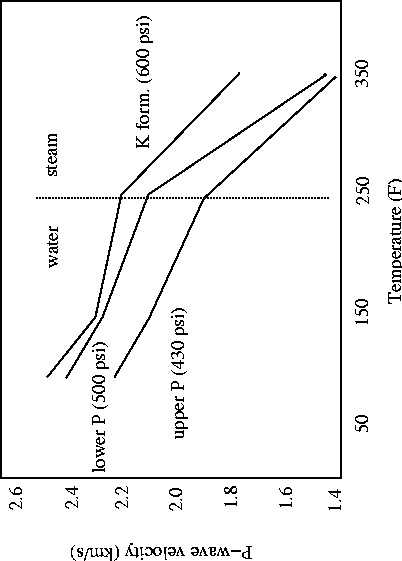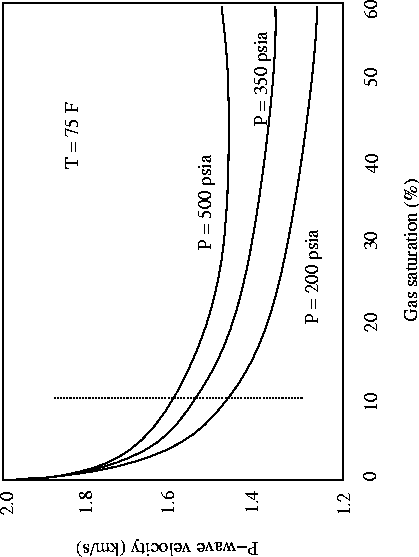




Next: Steamflood rock properties
Up: ROCK PHYSICS
Previous: Velocity vs. gas saturation
The Duri core measurements show that the density of dry samples
ranges from 1.54-1.67 g/cc. Assuming a grain density of 2.67 g/cc,
and an average porosity of 35%, a 100% water saturated sample
has a density of about 1.95 g/cc and does not vary with temperature.
A partially water saturated sample with 10% initial gas saturation
has a density of about 1.92 g/cc. The density of Duri oil varies
with temperature linearly from 0.92 g/cc at 80  F to 0.83 g/cc at
350
F to 0.83 g/cc at
350  F.
A sample with 50% oil, 40% water and 10% gas has a
density of about 1.90 g/cc at 100
F.
A sample with 50% oil, 40% water and 10% gas has a
density of about 1.90 g/cc at 100  F, and a density of 1.89 g/cc at 250
F, and a density of 1.89 g/cc at 250  F.
A sample with 10% oil and 90% gas (steam) at 350
F.
A sample with 10% oil and 90% gas (steam) at 350  F has a density
of about 1.63 g/cc. As far as seismic impedance changes are concerned,
the only case of interest is that of the steam zone, where density
will decrease about 15% compared to initial reservoir conditions.
All other scenarios cause negligible density changes, as described above.
F has a density
of about 1.63 g/cc. As far as seismic impedance changes are concerned,
the only case of interest is that of the steam zone, where density
will decrease about 15% compared to initial reservoir conditions.
All other scenarios cause negligible density changes, as described above.
Vptemp
Figure 11 P-wave velocity as a function of temperature
and overburden pressure for three saturated samples
from the upper P, lower P, and K formations
(after Wang and Cates, 1994).
 Vpsg
Vpsg
Figure 12 P-wave velocity as a function of gas saturation
for a saturated sample at differential pressures
of 200, 350 and 500 psia (after Wang and Cates, 1994).






Next: Steamflood rock properties
Up: ROCK PHYSICS
Previous: Velocity vs. gas saturation
Stanford Exploration Project
11/12/1997
![]() F to 0.83 g/cc at
350
F to 0.83 g/cc at
350 ![]() F.
A sample with 50% oil, 40% water and 10% gas has a
density of about 1.90 g/cc at 100
F.
A sample with 50% oil, 40% water and 10% gas has a
density of about 1.90 g/cc at 100 ![]() F, and a density of 1.89 g/cc at 250
F, and a density of 1.89 g/cc at 250 ![]() F.
A sample with 10% oil and 90% gas (steam) at 350
F.
A sample with 10% oil and 90% gas (steam) at 350 ![]() F has a density
of about 1.63 g/cc. As far as seismic impedance changes are concerned,
the only case of interest is that of the steam zone, where density
will decrease about 15% compared to initial reservoir conditions.
All other scenarios cause negligible density changes, as described above.
F has a density
of about 1.63 g/cc. As far as seismic impedance changes are concerned,
the only case of interest is that of the steam zone, where density
will decrease about 15% compared to initial reservoir conditions.
All other scenarios cause negligible density changes, as described above.

